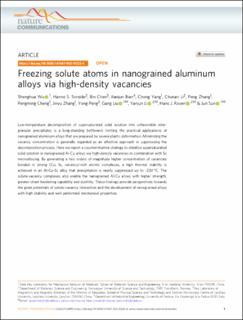| dc.contributor.author | Wu, Shenghua | |
| dc.contributor.author | Søreide, Hanne-Sofie | |
| dc.contributor.author | Li, Chunan | |
| dc.contributor.author | Liu, gang | |
| dc.contributor.author | Li, Yanjun | |
| dc.contributor.author | Roven, Hans Jørgen | |
| dc.contributor.author | Sun, Jun | |
| dc.date.accessioned | 2023-01-11T08:13:03Z | |
| dc.date.available | 2023-01-11T08:13:03Z | |
| dc.date.created | 2022-08-14T14:12:26Z | |
| dc.date.issued | 2022 | |
| dc.identifier.issn | 2041-1723 | |
| dc.identifier.uri | https://hdl.handle.net/11250/3042545 | |
| dc.description.abstract | Low-temperature decomposition of supersaturated solid solution into unfavorable intergranular precipitates is a long-standing bottleneck limiting the practical applications of nanograined aluminum alloys that are prepared by severe plastic deformation. Minimizing the vacancy concentration is generally regarded as an effective approach in suppressing the decomposition process. Here we report a counterintuitive strategy to stabilize supersaturated solid solution in nanograined Al-Cu alloys via high-density vacancies in combination with Sc microalloying. By generating a two orders of magnitude higher concentration of vacancies bonded in strong (Cu, Sc, vacancy)-rich atomic complexes, a high thermal stability is achieved in an Al-Cu-Sc alloy that precipitation is nearly suppressed up to ~230 °C. The solute-vacancy complexes also enable the nanograined Al-Cu alloys with higher strength, greater strain hardening capability and ductility. These findings provide perspectives towards the great potentials of solute-vacancy interaction and the development of nanograined alloys with high stability and well-performed mechanical properties. | en_US |
| dc.language.iso | eng | en_US |
| dc.publisher | Nature | en_US |
| dc.rights | Navngivelse 4.0 Internasjonal | * |
| dc.rights.uri | http://creativecommons.org/licenses/by/4.0/deed.no | * |
| dc.title | Freezing solute atoms in nanograined aluminum alloys via high-density vacancies | en_US |
| dc.title.alternative | Freezing solute atoms in nanograined aluminum alloys via high-density vacancies | en_US |
| dc.type | Peer reviewed | en_US |
| dc.type | Journal article | en_US |
| dc.description.version | publishedVersion | en_US |
| dc.source.volume | 13 | en_US |
| dc.source.journal | Nature Communications | en_US |
| dc.identifier.doi | https://doi.org/10.1038/s41467-022-31222-6 | |
| dc.identifier.cristin | 2042840 | |
| dc.relation.project | Norges forskningsråd: 269842 | en_US |
| dc.relation.project | Norges forskningsråd: 309584 | en_US |
| cristin.ispublished | true | |
| cristin.fulltext | original | |
| cristin.qualitycode | 2 | |

